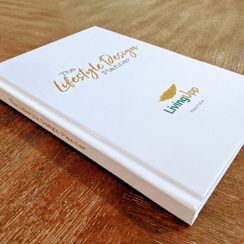I like to do my annual planning in December each year. In part, it’s because whenever I’ve waited until January, I’ve ended up feeling rushed and behind before the year even gets started. Carving out time for planning in December helps me begin the new year with a clear picture of what I want to experience in the months to come. This practice also helps me stay connected to my goals throughout the holiday season. And that means I get to enjoy more of it.
And if health is one of your priority areas for the coming year, planning ahead is even more important. The good news is, it doesn’t have to be difficult.
The planning process begins in your journal.
Why Planning is Essential
No matter how you feel about goal setting, most people consider January 1st to be a symbol of a fresh start. It’s an opportunity to press the motivational reset button, and look forward to something better in the year ahead.
While there’s still some disagreement among experts about whether setting New Year’s resolutions is an effective way to approach goal setting, it’s clear that being specific about your desires makes a big difference when it comes to your long-term success. Because when you’re clear about what you want, it’s easier to identify the actions you’ll need to take to get there.
“You can't hit a target you cannot see, and you cannot see a target you do not have.” - Zig Ziglar
Planning is an integral part of the behavior change process, especially when it comes to your lifestyle habits. If you want to improve your health, you’ll need to improve your habits.
The 4-R’s Planning Process
There are many ways to approach annual goal setting, but the easiest way I’ve found is to spend some time in my journal. I use a simple 4-part process that I often refer to as the 4 R’s: Reflect, Release, Realign, Redesign.
Here’s a quick summary:
Reflect on the past year.
Release what no longer serves you.
Realign with your desires.
Redesign your habits.
It’s that simple!
Here’s a quick overview of each of the 4 R’s:
Reflect
First, you’ll need to devote some time to reflecting back on the past year. Consider the goals that you’ve successfully completed, the challenging circumstances you’ve overcome, and any unexpected blessings that have occurred over the course of the year.
As you reflect back, you’ll also want to take note of the things that didn’t go so well. Perhaps there were a few goals on your list that you didn’t get around to, or maybe somewhere along the way they became irrelevant or less important.
The reflection process is an invitation for you to get really honest with yourself. Ask yourself whether you truly put forth the effort necessary to achieve your goals, and then explore the reasons why that might be.
Release
Next, it’s time to determine what you’re ready to release as you move into the new year.
Make a list of anything that you’re ready to let go of. This could include goals, relationships, beliefs, or habits that are no longer serving you in a positive way. One simple way to do this is to refer back to your notes from the reflection process and identify what jumps out at you from the pages. Are there items on your list that are no longer important?
For example, at one time I thought I wanted to learn how to play the mandolin. On a whim, I bought one and held onto it for ten years thinking that someday I’d get around to it. Year after year, “learn to play the mandolin” was on my list of goals. But at some point, I realized that the reason I’d never gotten around to it was that it no longer excited me. So, I donated it. And releasing that mandolin felt absolutely amazing.
As you review the items from your reflection exercise, consider which things no longer excite you or feel important. That will help guide you toward the things you might be ready to release.
Realign
The next step of the journaling process is perhaps the most important. Realigning with your highest priorities allows you to get clear about how you really want to experience your life—all of the things you want to do, be, have, and feel.
Imagine yourself healthy and happy. What are you doing (or not doing)? Where are you spending your time? Who is around you? This is where you get to use the full range of your imagination.
Then, make a list of the goals that you’ll need to achieve to make that vision a reality. Getting realigned with your priorities means that you’ll be able to invest your time, energy, and money more effectively and efficiently.
Redesign
Once you’ve completed the first 3 steps, it’s time to do a quick review. Read through your goals and intentions for the coming year and ask yourself what needs to change in your day-to-day life.
Which behaviors and habits will you need to adjust in order to move forward? What do you need to tweak in order to set yourself up for success? Journal prompts can be extremely helpful to find the answers.
Additional Journal Prompts
As you consider which actions will help you move closer to your goals, spend some time with the following journal prompts:
What am I ready to leave behind?
Which habits, behaviors, routines, and people do you need to let go of to embrace a new way of being? Consider what might be standing in the way of your success.
What do I want to come of this?
This is one of my favorite all-purpose journal prompts. It’s a simple way to shift your thoughts away from what you DON’T want, and toward what you DO want. If you’re feeling stuck or overwhelmed by your current life circumstances, use this journal prompt to _think forward_. It’s a great way to brainstorm creative solutions to a problem, or consider new possibilities that can help you improve your circumstances.
What am I moving toward?
Rather than getting stuck feeling disappointed about the goals you haven’t achieved in the past, envision the life you want to create. Describe what you want to experience as if you’re already living it. How are you spending your time? How do you feel physically? What emotions are you experiencing?
These journal prompts will help you get clear about what you want to achieve in the new year.
Conclusion
By integrating the Reflect-Release-Realign-Redesign exercise into your journaling practice, you can get a head start on planning a healthy
Information contained in this article is for educational purposes only and should not be interpreted as providing or replacing medical advice, diagnosis, or treatment.

Author bio: STACY FISHER, RDN, LD, CDCES is the founder of LivingUpp™, a lifestyle design company that teaches women how to use a self-care planning  system to create more ease and better health. She is a registered dietitian and lifestyle coach with 20+ years of experience in the healthcare industry, where she’s worked with large companies such as Dell, Boeing and Nike. Stacy is the author of The Lifestyle Design Planner, a flexible life organizer for high-achievers who value self-care and simplicity.
system to create more ease and better health. She is a registered dietitian and lifestyle coach with 20+ years of experience in the healthcare industry, where she’s worked with large companies such as Dell, Boeing and Nike. Stacy is the author of The Lifestyle Design Planner, a flexible life organizer for high-achievers who value self-care and simplicity.


Leave Comment